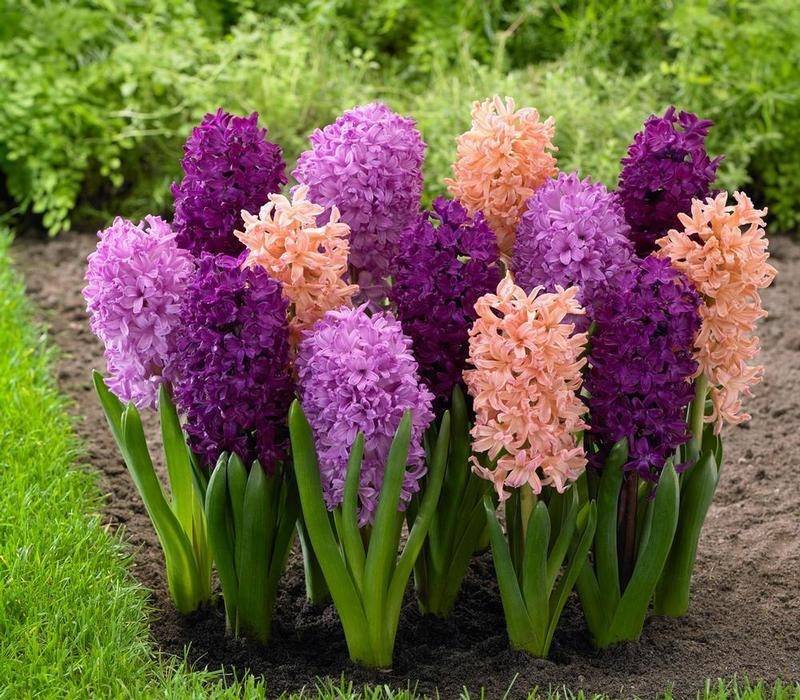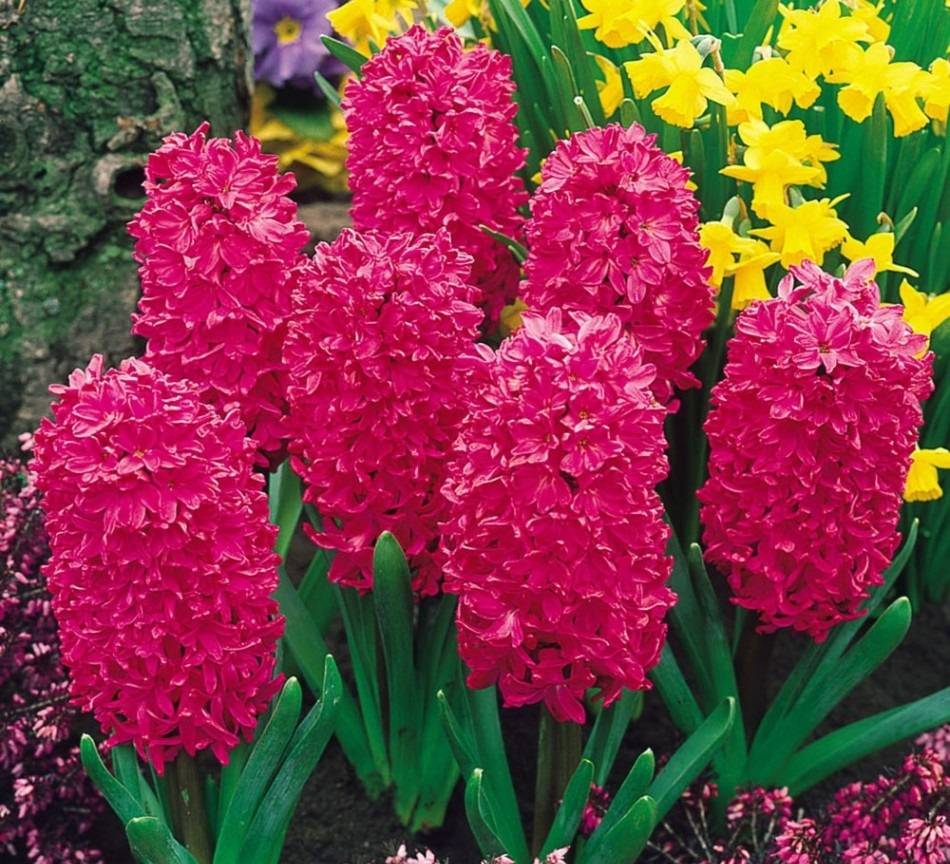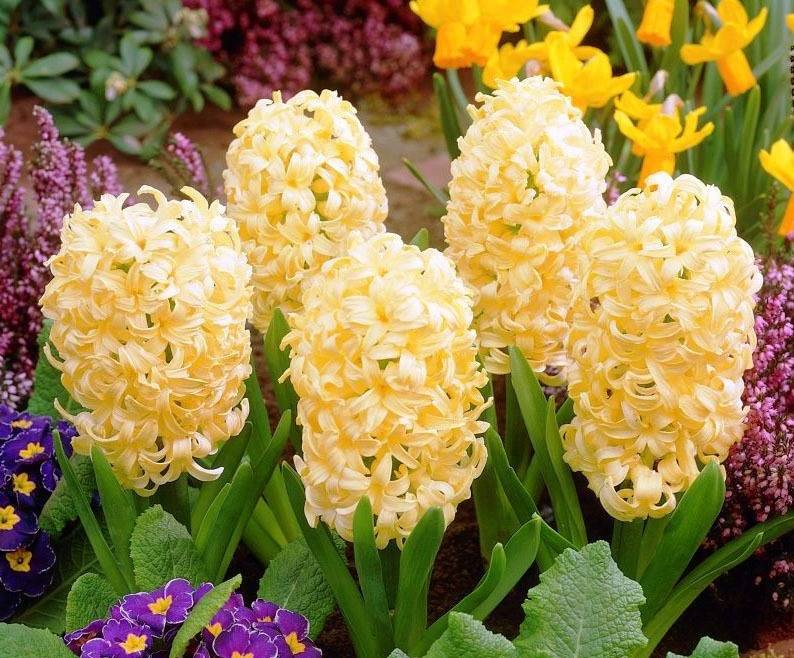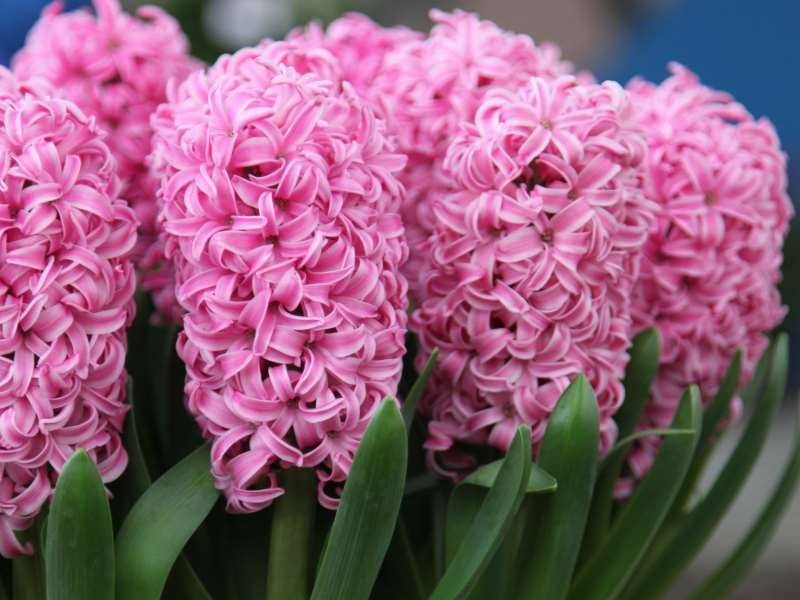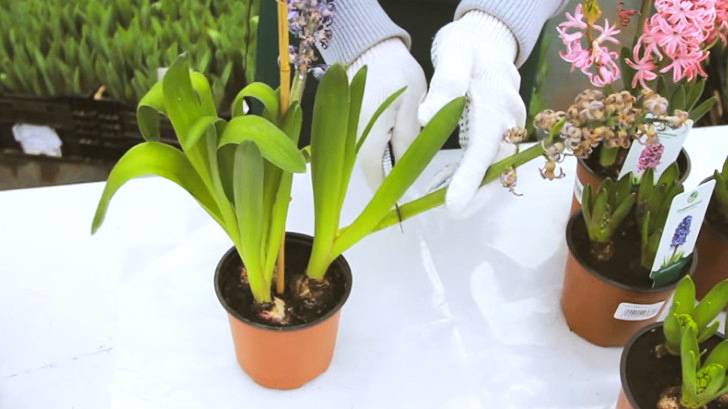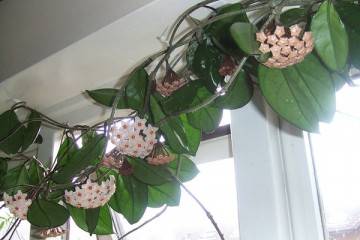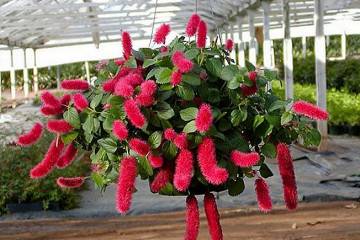Hyacinths: flowers, plant, home care
Content:
Hyacinths are flowers that have been known since ancient times. What is hyacinth? A perennial flower that is grown outdoors and in pots as a houseplant. What does hyacinth look like? A compact, low flower with glossy xiphoid leaf plates. Inflorescences are cylindrical, each with at least 15-20 small flowers. The color and size of petals and buds depends on the variety and variety.
Hyacinth history: legends and myths
Hyacinth is a plant associated with many legends and myths. The most famous of them, about the young man of the same name, in whose honor the flower got its name.
The legend tells about the young man Hyacinth, who was the favorite of the god of beauty Apollo. Together they loved to organize sports competitions. During one of these competitions, Apollo, throwing a heavy disc, hit the young man. Blood splattered on the green grass, and in its place beautiful lilac-scarlet flowers soon grew. The young man was not known at the time, but Apollo immortalized his memory with the appearance of a flower.
Another legend tells about the confrontation between Ajax and Odysseus, during the Trojan War. Both warriors wanted to get hold of the weapon of Achilles. By the unjust decision of the council of elders, after the death of Achilles, his weapon was given to Odysseus. In protest, Ajax stuck a sword in his heart. The drops of blood fell on the ground and a plant with flowers grew out of them, the shape of which was similar to the first letters in the name of the young man - alpha and upsilon.
For the inhabitants of Ancient Greece, the plant was still a symbol of wilting and resurrection of nature. And at weddings, Greek women adorned the hair of their girlfriends with wild hyacinth buds.
The inhabitants of eastern countries were the first to grow flowers at home. One Persian poet believed that flowers have a magical effect and compared them to the curls of girls.
Wild hyacinth in nature
The wild flower naturally grows in Central and East Asia, the Mediterranean coast and the Caucasus. The flower loves wet areas and begins to bloom in the last month of winter or early spring.
Types and varieties of hyacinths
Today there is a wide variety of plant varieties. They differ from each other in winter hardiness, color palette of inflorescences, resistance to diseases and unfavorable climatic conditions.
Oriental
The most famous type of flower. All the most popular and common varieties are derived from it. Wild oriental hyacinth is native to Syria, Lebanon and Turkey. The bushes have pink, white and blue inflorescences, which are located on long peduncles.
Hyacinth Jan bos
Jan Bos (Jan bos hyacinth) is an early flowering variety. It has inflorescences in the form of cylinders with small buds of a rich red hue. The edges of the petals are lighter in color.
Hyacinth Woodstock
Woodstock (Woodstock hyacinth) is one of the earliest pot and street cultivars. The buds are lilac shade, located on dense and long peduncles, reaching a length of almost 15 centimeters.The edges of the leaf plates are light lilac in color.
Hyacinth Dipsy Queen
The variety is distinguished by the color of the inflorescences of a delicate peach shade. Hyacinth Gipsy queen has dense and tough flowers, it seems that there is wax on the surface of the petals. Because of this unusual feature, the bush begins to bloom later than other varieties. Flowering lasts only 2-3 weeks.
Wild hyacinth
The wild or field species has flowers of rich blue and blue color, the same color has the Rembrandt variety. The shape of the buds resembles large bells. The plant grows in river valleys, in open areas.
Hyacinth Blue jacket
Hyacinth Blue jacket stands out with a different shade of inflorescence, which from bluish-lilac color turns into lighter shades. From a distance, it seems that the inflorescence of the Jackets variety has a striped color. The inflorescence is in the form of a cylinder, reaches a height of 30 centimeters and includes more than 30 small buds.
The variety is not highly resistant to cold and frost.
City of harlem hyacinth
The Hyacinth variety City of Harlem has large yellow flowers. The plant is in demand not only in home cultivation, but also in landscape design. The inflorescences are 13 centimeters long, while the plant itself does not exceed 30 centimeters in height.
Many are interested in the question of when the City of Harlem hyacinth blooms. The bush blooms in March, in northern latitudes in April. Flowering lasts a whole month.
Hyacinth Yellowstone
Hyacinth Yellowstone has large, pale yellow inflorescences. The plant grows no more than 40 centimeters, and does not grow more than 10 centimeters in diameter. winter hardiness of the bush is low.
Hyacinth Carnegie
Hyacinth Carnegie (Carnegie) is a rare frost-resistant variety that can withstand cold temperatures of -34 degrees. A bush with a cylindrical inflorescence has snow-white flowers like paper.
Forest hyacinth
The forest species in its natural environment is more often found near deciduous forests. Another name for the species is mouse or muscari.
Bright blue or blue inflorescences are located on a tall and dense peduncle. The flowers are tubular and have a light border around the edges.
Hyacinth Anna Lisa
The Anna Lisa variety is famous for its bright lilac inflorescences, which shine a little in the sun, as if they have a mother-of-pearl coating. The plant reaches a height of 30 centimeters.
Hyacinth Pink Pearl
The inflorescence of this variety has the shape of a cone. The flowers are deep pink with dark lines at the perianths. A distinctive feature of this variety are long bracts resembling leaf plates. Each bracts can be up to 7 centimeters long.
Hyacinth Wurbak
Another variety with a cone-shaped inflorescence, on which pinkish-purple buds are densely located, in the form of stars. The bush will not grow more than 30 centimeters in length. It begins to bloom in early spring.
Hyacinth Splendid cornelia
The variety is famous for its large pale lilac or pink buds, which are densely located on a dense peduncle. The plant reaches a height of no more than 30 centimeters, half of which is the length of its inflorescence.
Hyacinth Hollyhock
One of the latest flowering varieties. It's all about its double and very dense petals, which take a long time to appear and ripen. But Hollyhock is not afraid of cold and piercing winds. The small flowers of the variety have a rich scarlet color.
Hyacinth care at home
It is necessary to provide proper and gentle care at home - hyacinth requires special attention. Careful and attentive cultivation will help protect against disease and achieve abundant and vibrant flowering.
It is necessary to choose healthy planting material for planting and use disinfected garden tools.
Also, the plant requires regular feeding with mineral and organic fertilizers. You cannot fertilize flowers more than 2 times a month, this will negatively affect their condition.
- In the spring, it is necessary to apply nitrogen fertilizers in the form of superphosphates or nitrate.
- As soon as the bushes begin to form buds, nitrogen-containing fertilizing is stopped and potash and phosphorus fertilizers are applied.
Watering and humidity
Hyacinth is a moisture-loving bush, and its name means "rain flower" for a reason. Therefore, you need to provide him with regular watering. Each watering must be accompanied by subsequent loosening of the soil. This procedure will prevent the formation of stagnant moisture in the ground.
The soil under the flower should be loose and moist all the time. In dry periods, the abundance of irrigation increases and additionally increases the humidity of the air. For this, the ground part of the bush is sprayed with water from a spray bottle.
Location and lighting
Although the plant is light-loving, it should not be left in direct sunlight for a long time. It is better to grow a bush not on the south side, but choose east or southeast windows. The optimal duration of daily sun exposure is 15 hours.
During periods when natural light is not enough, phytolamps need to be installed. If the weather is clear and hot, it is necessary to place the pot in shady areas.
Problems of growing hyacinths
When growing a plant at home, various problems often arise. Some of them are very serious - if you start the state of the flower, it can completely die.
The most common problems that arise when growing a flower:
- lack of flowering, arising from a pot that is too large in capacity;
- yellowing of leaf plates due to lack of moisture and light;
- deformation of petals and leaves due to hypothermia of the entire bush:
- falling leaves due to waterlogging of the soil.
Having figured out what kind of hyacinth flower is, how to care for it correctly and not bring on problems in the form of diseases, any gardener will be able to grow a plant on his site. Of course, it won't always be easy. But the result is worth it. It takes a lot of effort to grow a healthy shrub at home. However, then the flower will delight you with its bright and abundant flowering.
